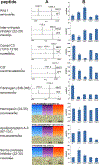The Plethora of Angiotensin-Converting Enzyme-Processed Peptides in Mouse Plasma
- PMID: 31021607
- PMCID: PMC6693507
- DOI: 10.1021/acs.analchem.8b03828
The Plethora of Angiotensin-Converting Enzyme-Processed Peptides in Mouse Plasma
Abstract
Angiotensin-converting enzyme (ACE) converts angiotensin I into the potent vasoconstrictor angiotensin II, which regulates blood pressure. However, ACE activity is also essential for other physiological functions, presumably through processing of peptides unrelated to angiotensin. The goal of this study was to identify novel natural substrates and products of ACE through a series of mass-spectrometric experiments. This included comparing the ACE-treated and untreated plasma peptidomes of ACE-knockout (KO) mice, validation with select synthetic peptides, and a quantitative in vivo study of ACE substrates in mice with distinct genetic ACE backgrounds. In total, 244 natural peptides were identified ex vivo as possible substrates or products of ACE, demonstrating high promiscuity of the enzyme. ACE prefers to cleave substrates with Phe or Leu at the C-terminal P2' position and Gly in the P6 position. Pro in P1' and Iso in P1 are typical residues in peptides that ACE does not cleave. Several of the novel ACE substrates are known to have biological activities, including a fragment of complement C3, the spasmogenic C3f, which was processed by ACE ex vivo and in vitro. Analyses with N-domain-inactive (NKO) ACE allowed clarification of domain selectivity toward substrates. The in vivo ACE-substrate concentrations in WT, transgenic ACE-KO, NKO, and CKO mice correspond well with the in vitro observations in that higher levels of the ACE substrates were observed when the processing domain was knocked out. This study highlights the vast extent of ACE promiscuity and provides a valuable platform for further investigations of ACE functionality.
Conflict of interest statement
Notes
The authors declare no competing financial interest.
Figures


References
Publication types
MeSH terms
Substances
Grants and funding
LinkOut - more resources
Full Text Sources
Molecular Biology Databases
Research Materials
Miscellaneous

